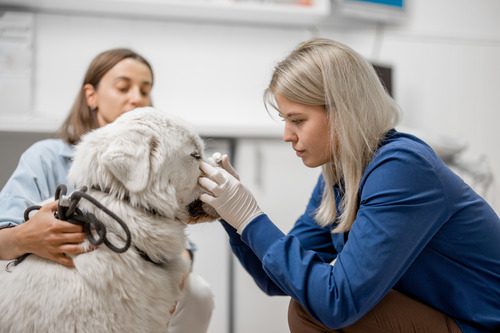When the weather gets chilly, it’s easy to forget that your dog might feel the cold just as much as you do. Hypothermia is a serious condition that can affect dogs, especially during the colder months. Knowing what causes dog hypothermia, how to recognize the symptoms, and what you can do to treat and prevent it is crucial for keeping your dog safe. If you think your dog might be at risk of hypothermia, call South Loop Animal Hospital at (312) 753-5551 or make an appointment today.
Why Do Dogs Get Hypothermia?
Hypothermia happens when your dog’s body temperature drops below normal due to prolonged exposure to cold temperatures. This can happen if your dog is left outside in the cold for too long, especially without proper shelter or clothing. Small dogs, dogs with thin coats, puppies, and older dogs are more susceptible to hypothermia, but every dog can be at risk. Even if it’s not freezing outside, wet fur and wind can increase the risk of hypothermia in dogs.
Hypothermia can also occur if your dog gets wet and is unable to dry off quickly. For example, falling into a cold body of water or being out in the rain for an extended amount of time can lower your dog’s body temperature rapidly. Additionally, medical conditions that affect a dog’s ability to regulate body temperature, such as hypothyroidism, can make them more prone to hypothermia.
Spotting the Signs of Hypothermia in Your Dog
Early signs of dog hypothermia include shivering, lethargy, and a lack of coordination. As the condition worsens, your dog may stop shivering and become weak, with cold ears and paws. Severe hypothermia can lead to difficulty breathing, muscle stiffness, and a slow heartbeat.
If your dog seems disoriented, is whining, or appears to be in pain, these could also be signs of hypothermia. In extreme cases, hypothermia can cause your dog to lose consciousness or even lead to death if they are not treated right away. If you notice any of these symptoms, you need to take action immediately.
Steps to Take if Your Dog Has Hypothermia
If you suspect your dog has hypothermia, take action right away.
Warm Your Pet
Start by bringing your dog into a warm, dry place. Wrap them in blankets or towels to help raise their body temperature, but be sure not to apply direct heat, such as a heating pad, as this could cause burns. Instead, warm the blankets or towels slightly in the dryer or use your own body heat to warm your dog gradually.
Monitor Their Temperature
Check your dog’s temperature using a rectal thermometer if possible. A normal dog’s body temperature should be between 101 and 102.5 degrees Fahrenheit. If your dog’s temperature drops below 99 degrees Fahrenheit, this is an emergency, and you should call your vet immediately.
Get in Touch with Your Vet
In cases of mild hypothermia, warming your dog and providing them with warm fluids may be enough to restore their temperature. However, if your dog is unresponsive, has a very low body temperature, or you notice any severe symptoms, get veterinary help as soon as possible. Your vet may need to provide intravenous fluids, oxygen, or other treatments to stabilize your dog’s condition.
Preventing Hypothermia in Dogs
Here’s what you can do to protect your dog from hypothermia:
- Always monitor the temperature before allowing your dog outside, and limit their time outdoors on particularly cold or wet days.
- Provide your dog with a warm, dry place to rest inside, and consider using a dog sweater or coat for added warmth, especially for short-haired breeds or small dogs.
- If you’re planning to spend time outside with your dog during cold weather, make sure they are well-prepared.
- Avoid letting your dog swim in cold water, and dry them off immediately if they get wet.
- It’s also a good idea to keep your dog on a leash to prevent them from running off and getting lost if it’s cold outside.
- Keep an eye on your dog’s behavior when you’re outside. If they start shivering or appear uncomfortable, it’s time to go back inside.
- Remember that some dogs, especially older ones, may need extra protection during the winter months, so don’t hesitate to bring them in if they seem too cold.
When Should You Contact Your Vet About Hypothermia?
If your dog is showing symptoms like severe shivering, lethargy, or difficulty breathing, call South Loop Animal Hospital at (312) 753-5551 right away. Even if the symptoms seem mild, it’s better to be safe and have your dog checked out by a professional.
In many cases, early intervention can prevent hypothermia from becoming a life-threatening condition. We can provide the necessary care and advice to help your dog recover quickly and prevent future occurrences.







